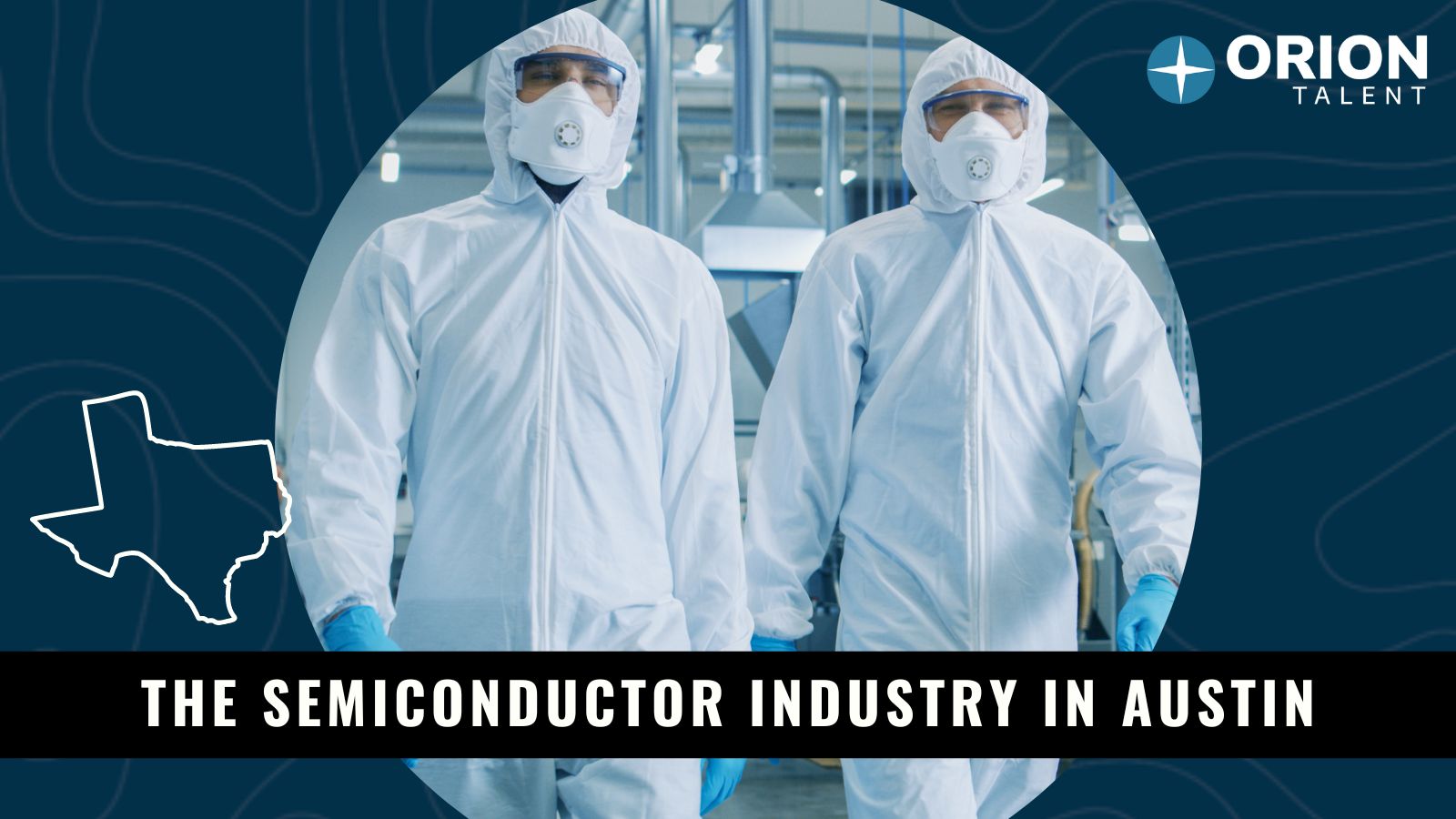
Semiconductors have driven advances in communications, computing, health care, military systems, transportation, clean energy, and countless other applications. Without semiconductors, integrated circuits, transistors, solar cells, and many other computing materials would not exist. They have a significant impact on our world and technology that is vital to the computing and electronic product supply chain.
Read on to learn more about semiconductors, Austin’s significance in driving growth within the industry, and future trends for the semiconductor industry.
Semiconductors: What Are They, And Why Are They Important?
Semiconductors are tiny chips that power modern technologies. They are a type of material that is similar to rubber that conducts electricity. Silicon, germanium, and gallium arsenide are a few of the most common types of semiconductor material.
Semiconductors are crucial components in most modern electronics, especially computers, smartphones, and other electronic devices. As a result, semiconductors are vital to America’s economy, national security, and continued global leadership in research, design, and manufacturing.
The semiconductor industry is expecting continued growth and expansion due to technological innovation and the rapidly growing use of AI. Tens of thousands of new semiconductor jobs will be created in the U.S. over the next decade to meet capacity needs for critical applications.
Within recent years, the city of Austin, Texas, has risen to meet the demands of the semiconductor industry, becoming a major hub for semiconductor manufacturing.
Austin’s Thriving Semiconductor Industry
Austin has become a hotspot for semiconductor manufacturing for a number of reasons. The state’s climate and low-risk region of the U.S. in terms of natural disasters make it a desirable place for semiconductor corporations to build their facilities.
Texas boasts a huge talent pool and is home to the second-largest workforce, totaling 14 million. It consistently ranks as the top state for population growth nationally, and Austin always finds its way onto the lists of the best places to live and work.
Add to that is the sheer size of Texas, with 268,597 square miles of landmass, which allows for semiconductor fabs and foundries to spread out and build.
Who are Austin’s biggest semiconductor employers?
Austin’s biggest semiconductor employers include:
-
NXP
-
Applied Materials
-
Infineon Technologies
-
AMD
All of these semiconductor powerhouses boast massive facilities; for example, NXP’s Austin campus is over 2 million square feet, and Samsung’s facility is the largest operation outside of South Korea.
In addition, these major players in the foundry market host over 11,000 total jobs for Austin in the semiconductor industry.
Future Growth Trajectories
U.S. semiconductor manufacturing growth has decreased significantly since 1990, due to competing nations offering much better incentives for manufacturers.
However, this decrease in manufacturing has not affected the semiconductor world in Texas. Since 2015, there has been a 35% increase in semiconductor facilities, with over 200 facilities in the state and over 29,000 total jobs.
Due to Texas’ recent success in the market, there are multiple U.S. legislative initiatives currently pending designed to facilitate more manufacturing domestically.
The CHIPS and Science Act
Proposed by President Biden and signed into law earlier this month, the CHIPS and Science Act will invest $52B in domestic semiconductor manufacturing and research. The bill is intended to help make the US more competitive with China and Taiwan in the semiconductor industry.
The CHIPS and Science Act will help build, expand, and modernize facilities and equipment for semiconductor production and accelerate research in AI, quantum computing, 6G, hypersonics and other national security technologies.
The Facilitating American-Built Semiconductors (FABS) Act
Introduced in June 2021 by a bipartisan group of senators, the Facilitation American-Built Semiconductor (FABS) Act is legislation that will establish a 25 percent tax credit for investments in semiconductor manufacturing, both for manufacturing equipment as well as the construction of semiconductor manufacturing facilities.
Texas’s Semiconductor Task Force
Texas Governor Greg Abbott established a Texas semiconductor task force earlier this year, which will coordinate the development of a proposal to the U.S. Department of Commerce with the intention of making Texas the future site of the National Semiconductor Technology Center (NSTC) and the National Advanced Packaging Manufacturing Program (NAPMP).
The Texas Task Force will be composed of semiconductor industry stakeholders from the private sector, community partners, and higher education institutions to collaborate on the Texas initiative.
“With Texas at the helm of this initiative, our growing tech community, world class research institutions, and emphasis on innovation through collaboration will surely keep the nation on the cutting-edge of advancements in this sector. Texas offers the foundation necessary to fully address the country’s commercial and defense needs in the semiconductor arena,” Governor Greg Abbott stated.
The Task Force has expanded semiconductor operations in Texas exponentially, with Samsung now currently considering building another new facility in Austin.
Start Your Semiconductor Career with Orion Talent
There is no better time to start a career in the semiconductor industry, especially in Austin, Texas. As the U.S. continues to become a major powerhouse in the field, the demand for talent to fill positions within the industry will continue to grow.
Find out more about semiconductor careers through Orion Talent, including types of positions we typically recruit for in the industry, and semi conductor jobs in Texas.
Learn more about semiconductor in:
Additional Interview Resources
How to Prepare for a Management Interview
Looking for a management position in the semiconductor industry? Check out our tips for interviewing for a management level role.
Preparing for a Sales Interview
Looking for a career in semiconductor sales? Read this guide first.
Archives
- July 2025
- June 2025
- May 2025
- April 2025
- March 2025
- February 2025
- October 2024
- May 2024
- March 2024
- February 2024
- January 2024
- December 2023
- November 2023
- October 2023
- September 2023
- August 2023
- July 2023
- June 2023
- May 2023
- April 2023
- March 2023
- February 2023
- January 2023
- December 2022
- November 2022
- October 2022
- September 2022
- August 2022
- July 2022
- June 2022
- May 2022
- April 2022
- March 2022
- February 2022
- January 2022
- December 2021
- November 2021
- October 2021
- September 2021
- August 2021
- July 2021
- June 2021
- May 2021
- April 2021
- March 2021
- February 2021
- January 2021
- December 2020
- November 2020
- October 2020
- September 2020
- August 2020
- July 2020
- June 2020
- May 2020
- April 2020
- March 2020
- February 2020
- January 2020
- December 2019
- November 2019
- October 2019
- September 2019
- August 2019
- July 2019
- June 2019
- May 2019
- April 2019
- March 2019
- February 2019
- January 2019
- December 2018
- November 2018
- October 2018
- September 2018
- August 2018
- July 2018
- June 2018
- May 2018
- April 2018
- March 2018
- February 2018
- January 2018
- December 2017
- November 2017
- October 2017
- September 2017
- August 2017
- July 2017
- June 2017
- May 2017
- March 2017
- February 2017
- January 2017
 RSS Feed
RSS Feed
Subscribe to Orion's Blog
Featured Blogs





.jpg)














